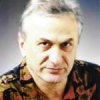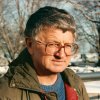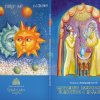Ivanovich's paintings have ranged from the thick, textured oils of his expressionistic figures and post impressionistic landscapes, to the 'crystallized' transparency of his frozen watercolor. The majority of Ivanovich's work is painted using the revolutionary frozen technique, combining colorful realism, mystique and fantasy with a harmonious cracking of the paint pigments, reminiscent of frosted windowpanes on a cold, winter morning.
The secret of his technique lies in the placing of the wet painting into cold temperatures under these extreme conditions of cold the watercolor - pigment-frieze and crack, creating an indescribably beautiful effect.
His bold, narrative paintings depict figures set in surreal landscapes and fantastic situations that convey universal meanings. Each figure appears to be at odds with its environment, yet fixed in space. Many paintings portray or suggest aggressive confrontations interpreted from history, classical mythology and combined with his dream. This artist media is very complicated. He feels so comfortable that he is using the same process with oil painting. Result is unbelievable.
He studied Art at the University of Sarajevo, Yugoslavia - School of Fine Arts in 1965. Ivanovich came to the United States in 1967 and received his M.S. in Art at the University of Wisconsin, Milwaukee in 1972. If the tempo of his artistic accomplishments is maintained the name of Arso Ivanovich will join the ranks of the great artist of our time. His works will bring untold pleasure for lovers of fine art throughout the world.
"I strive to make every painting I do different", Ivanovich explains. "There is simply no other way, no other choice if I remain an artist. I have to trust myself and paint for myself. My art is my world, my world is my painting, my painting is my life." "Artists must believe that they will active their poetic end by means of beautiful models or beautiful motifs. We rather trust, we shall reach it by means of beautiful elements, for indeed the most beautiful of elements are certainly those of the mind. In my paintings all extreme forces of vision come in one composition. I am painting for myself, to satisfy my soul. Art is like language that everyone understands, but very few people can speak."
Ivanovich has more than 150 articles in newspapers and magazines here and abroad. His works are included in:
- Yugoslavia Encyclopedia of Art
- Encyclopedia of Living Artists
- Who's Who in American Art 1995 - 2001
- Serbs in the World - Who is Who
- Contemporary Artists of Montenegro.
Arso Ivanovich has 39 one-man shows including:
- Art Expo (1985) - New York, NY
- Art Expo (1986) - Los Angeles, CA
- Museum - Kenosha, WI
- Museum - Milwaukee, WI (group show)
- West Bend Gallery - West Bend, WI
- Rotunda Building - Madison, WI (Parliament Building)
- Gallery of the Wisconsin Academy of Art and Science - Madison, WI
- National Museum - Belgrade, Yugoslavia (group show)
Арсо Ивановић - биографија
Арсо је рођен прије 82 године у селу Лалевићи код Даниловграда. Говорио је да би рано дјетињство најрадије заборавио. Током четири године рата осам пута је објежао из куће, четири пута од партизана и четири пута од Италијана. Са непуних 6 година остао је без оца, припадника монархистичког покрета. Основну школу завршио је у Даниловграду, Учитељску школу у Тузли. У Сарајеву је започео студије ликовног образовања на Педагошкој академији, а на Филозофском факултету паралелно студије руског језика.
У САД се доселио 1967. године. Након завршетка студија ликовне умјетности у Милвокију радио је у средњој школи и колеџу, и као слободан умјетник. Имао је велики број изложби у САД. У старом крају имао је пет изложби, у Сарајеву, Београду, Подгорици, Тивту и Херцег Новом. 1990. године у организацији Матице српске у Београду организована је изложба "Срби, ликовни умјетници из свијета". На тој изложби представио се огромним платном, Косовским триптихом, именованим као Српски холокауст, која се данас налази у Музеју Србије.
Излагао је и на Свјетској изложби у Њујорку, Експо 86. Дакле, његови радови уврштени су у ред најбољих сликара свијета тих година.
Његова животна жеља била је да живи у Калифорнији, гдје ће имати и вјечни починак.
Arso Ivanovich - in from the cold
by Joel Miksch, Art Critic
Arso Ivanovich is graduate of the University of Sarajevo's Faculty of Philosophy and School of Fine Arts /1965/. He left his native land, Yugoslavia in 1967 to earn his Master's degree in Fine Arts from the University of Wisconsin at Milwaukee /1972/. Currently living and working in San Diego, while keeping close contact with family and friends in Montenegro, his life is as much a study in transition, voyage and discovery as the art he creates. He has recently been named the Encyclopedia of Living Artists as the founder and Master of his "crystallized watercolor" technique.
Of the literature, which exists on Ivanovich, much has been said regarding the inspiration he seeks from his homeland. Without discrediting the evolution of Ivanovich's surreal composition, or the native imagery and iconography his works frequently contain, this essay will attempt to touch on the transition created within the crystallization itself. While social and political transition certainly man have influenced the search for and development of this innovative technique, specific background and experiences are less significant that the tangible, physical exploration and transition his work is representative of. His crystallization should be viewed as a profound metaphor for life, rich in internal conflicts, contradictions and contrasts. This can be explored on several levels, as related to form, content and theory involved in Ivanovich's existing body of work in his "crystallized" technique.
Ivanovich's signature "crystallization", his most impressive body of work, originated in watercolor through the freezing of liquid color to created new, bold and interesting patterns in which to work. The artist recalls cold Yugoslavian winters during his formal training, and the redundancy of both leading to his frequent daydreaming through ice-frosted windows. The development and control of crystallization aesthetically would become his passion and obsession over the next twenty years. The terms "crystallized watercolor" and "frozen watercolor" frequently associated with his name will be abandoned for the purposes of this essay, and "crystallization" will prove more accurate. For, in recent years, Ivanovich has even transcended his original watercolor media to oils. While he considers this new achievement to be his mature style, the essential crystallization characteristics he achieves in both media are what will be referred to as his trademark technique.
Formally, Ivanovich is a master of composition and color. His range of work has embodied qualities of pure design, fragmented surrealism and cubistic abstraction.
Yet to understand how his crystallization lends itself so perfectly to his compositional mastery, we must abandon the preconceptions and categories these words tend to engender. Although words can often help us to understand it is at precisely that moment when we tend to stop looking, and stop seeing. Ivanovich's work is far richer than terms or comparisons can help define. The crystallization that he utilizes becomes part of the composition and provides its drama and dynamic. His crystallization transcends traditional styles and techniques just as the crystal itself transcends its original properties. What were once liquid pigments evolve and grow into a new concept of form and content, taking on a "new life". The significance of the crystal is growth, change and evolution. Compositionally, it continually evolves with each addressing of the image - seemingly before your eyes. It constantly grows, modifies itself, and matures with experience... as does Ivanovich as the artist, as does life, as do we as individuals. "I want the person looking at my painting to see more and more", the artist states. It is as much a lesson in art appreciation as it is life: we must learn to look. For many, beauty is left as a superficial level, easily digested and easily disposed. It is the emotional baggage which each of us brings to his images, which account for part of its communicative, emotive qualities.
As briefly mentioned above, the content Ivanovich frequently incorporates depicts images from his homeland. Yet more significant than the iconography itself is how content is used with form. In other words, less relevant are the memories Ivanovich chooses, and of greater importance is how he incorporates them into his work.
Color helps created this meditative, arousing, associative sense of space. Images rise like ghosts from the past shadowed by frozen fireworks bursting beautiful. For the views, the result may be romantic melancholy, longing or loss. It is the nature of memory, nostalgia and reminiscence, which Ivanovich seeks to convey. Ivanovich feels that he has gone as far with realism as he could during formal training. He states that intellectually, his crystallization technique allow him to transcend time, space and reality. He describes this surrealist state as similar to "the moment of awakening... the transitional state between dream and reality". His result is an incredible blend of formal elements - unique rhythms and repetitions, unity and variety. It is a place of pure, lyrical beauty which whispers of non-material and unwritten secrets, potential and possibility.
It is the thirst for discovery, the exploration itself that is priority to Ivanovich. "If a human being doesn't create something", he states, "he may be physically alive, but mentally dead". The artist feels that he learns something new about his technique every time he addresses his canvas. It is the experimentation - each success or failure which yields understanding into his technique. It is here where theory lends itself perfectly to technique. Ivanovich's crystallization is a constant exploration of new formation, values, and patterns created within his pigments. Process is significant, echoed in the crystallization process itself. While Ivanovich can control precisely where he wants to add his crystallization, the beauty in these forms, of course, create themselves. It is at the same time a harnessing of nature, as well as a surrender to it. Much like life, control and fate must be balanced. Some experiences are more successful than others. Yet in order to achieve, to pioneer and invent, one must have the courage to abandon the traditional and established. It is here where Ivanovich takes his place within the history of art - as a pioneer, explorer, innovator, and an original thinker. Each and every painting, composition, and crystallized passage is unique and individual. His works can never be duplicated, not even by the master himself. Truly, it is not the destination, but the journey.
SMRZNUTI AKVARELI
NIN, 12/22/95; Strana: 38
ARSO IVANOVIĆ, SLIKAR IZ VISKONSINA
Kristalizacijom boja, jedinstvenim slikarskim postupkom u svetu, jugoslovenski slikar ušao u američku umetničku elitu
Otišavši pre skoro trideset godina u Sjedinjene Američke Države, Arso Ivanović, rodom iz Danilovgrada, probio se među vrhunske slikare ove zemlje. Prošle godine njegovo ime je dospelo u Enciklopediju živih umetnika SAD, a nedavno i u publikaciju Ko je ko u američkoj umetnosti. Njegov nedavni boravak u Beogradu iskoristili smo za ovaj razgovor.
Kako je bilo prvih dana u Americi?
- Iz Sarajeva, gde sam studirao na Likovnoj akademiji, dospeo sam, pre ravno 27 godina, u Viskonsin gde sam odmah prionuo na rad. A pošto nisam dobro znao engleski, potrošio sam prvu godinu i na njegovo usavršavanje. Posle završetka studija magistrirao sam na litografiji a uskoro i na ulju. Prvu samostalnu izložbu imao sam u Milvokiju još prve godine po dolasku. Izložio sam tridesetak litografija i nekoliko ulja u Galeriji L' Atélier.
I tako, posle nepune tri decenije, dobili ste priznanje koje se retko kom slikaru ukazuje. Praktično ste ušli u američku umetničku elitu.
- Verovatno je to bio rezultat sistematskog rada. Nisam bio mnogo zainteresovan za komercijalni efekat. Radio sam ono što mislim da treba da radim kao umetnik. Rezultat toga rada je ne samo to što sam dospeo među 180 do 200 slikara koji se nalaze u najnovijoj ediciji Ko je ko u američkoj umetnosti, nego je moja slika Srpski holokaust reprodukovana na celoj stranici Enciklopedije živih američkih umetnika, koja je izašla prošle godine. U tom pogledu dosta sam zadovoljan.
U vašoj biografiji i prikazima vaših izložbi često se pominje tehnika "smrznutog akvarela", odnosno kristalizacije boja kao jedinstven slikarski prosede. Da li biste za čitaoce NIN-a rekli nešto više o tome?
- O kristalizaciji boja počeo sam da razmišljam pre nekih 25 godina. U podsvesti, imao sam neku ideju da tu može nešto da se napravi. Naime, dok je grupa postdiplomaca istraživala neke nove tehnike slikanja, ja sam odlazio do prozora i posmatrao kako mraz pravi kristale na oknima. Pitao sam se kako bih ja ove kristale mogao da bacim na papir, ali pod uslovom da zadržim pigment a da odstranim vlagu iz papira.
Tom idejom sam se bavio oko dve-tri godine. Pravio sam brojne eksperimente, ali, nažalost, nije bilo nikog u svetu ko bi mi dao bilo kakav savet. Svi kojima bih pomenuo tu ideju gledali su me s podozrenjem, da ne kažem s podsmehom, misleći da sanjam o nečem nemogućem. Međutim, ja sam u dnu duše bio uveren da postoji nešto. Osećao sam se kao putnik izgubljen u nekom tunelu, ali sam nazirao neko svetlo, neku iskricu na njegovom kraju. Osećao sam da do te iskrice moram doći. Ako budem sedeo, neću ništa uraditi. Ako budem tražio, onda postoji mogućnost da izađem iz tog tunela, odnosno da uspem. Znao sam da je umetnikova dužnost da traži. Onaj koji u jednom trenutku pomisli da je našao sebe i prestane da dalje istražuje, taj je intelektualno mrtav. Tako sam nastavio eksperimente pri niskim temperaturama, kad dolazi do "eksplozije" boja. To sam radio u savezu s prirodom. Potrošio sam veoma mnogo vremena i valjda još više papira. Najzad sam uspeo.
Koliko vam je vremena za to bilo potrebno?
- Trebalo mi je tri do četiri godine intenzivnog rada, neprospavanih noći, čak su mi i ruke promrzle. Naime, kod nas, tamo u državi Viskonsin, temperatura se spušta i do minus pedeset, a pretprošle godine je čak bilo minus 65. Slika je najbolja kad se napolju radi na temperaturi od minus pet do minus deset. Danas ima oko stotinak umetnika u svetu koji me slede. Čak ih ima i ovde, u Jugoslaviji. Ali mislim da oni nemaju rutine, da se još uvek plaše, ruka im je još ukočena, kao da su je umotali gipsom. Treba mnogo više slobode, fleksibilnosti i da misao ide pre nego što slika počne da se pojavljuje.
Praktično, vi ste jedini u svetu koji uspešno primenjuje tu tehniku smrzavanja boja?
- Mislim da sam jedini. O tome su pisale i neke američke novine. Bilo je to ključno pitanje 1986, kad sam izlagao na Svetskoj izložbi u Njujorku. I ta izložba je, verovatno, bila prelomna jer ko se dokaže u Njujorku, taj ide u istoriju umetnosti. Pariz je postao trećerazredni kad se radi o slikarstvu. Sada je Njujork broj jedan. I ta njujorška selekcija, kriterijumi, Svetska izložba, čini mi se, otvorili su mi vrata. Imao sam tu sreću da od desetak hiljada umetnika uđem među odabrane, njih oko 180. Posebno zahvaljujući tehnici kristalizacije (zamrzavanja boja).
Vaše slike već se nalaze i u Narodnom muzeju u Beogradu. Hoćete li nam reći nešto više o njima?
- Moja velika slika, triptih, dugačka više od četiri a visoka oko metar i osamdeset nosi ime Serbian holocaust. Ta moja slika nastala je pre šest godina, dakle pre nego što nam se desila ova nesreća. Prosto me je intuicija navela da nazrem šta će se desiti Jugoslaviji. Ukratko, hteo sam da prikažem da su Srbi krvlju plaćali svoju slobodu, da su danas bez mnogo nade i bez volje ali da nije sve izgubljeno...
Imate tu privilegiju da naše slikarstvo posmatrate sa strane. Šta o njemu mislite i gde mu je mesto u svetskom slikarstvu?
- Pre svega, moram da napomenem da svi slikari ne samo jugoslovenskog, srpskog, nego i slovenskog porekla imaju tako snažan osećaj za boju koji, čini mi se, druge nacije nemaju. To mirne duše mogu da kažem i naši slikari treba da budu potpuno sigurni u sebe, da stvaraju ono što misle da treba da stvaraju, a ne da se bave politikom. A to je, nažalost, često slučaj na ovim prostorima.
Znam da je to često nezahvalno, ali da li biste nam mogli reći ko od naših slikara predstavlja svetsko ime?
- Kad govorimo o slikarima koji bi mogli biti na svetskom nivou, smatram da su to od starijih Petar Lubarda ili Milunović, mada se u svetskim publikacijama retko pominje bilo koji od naših. Od savremenih ja lično najviše cenim Dada Đurića koji se među prvima, posle Drugog svetskog rata, otisnuo u Pariz. On je prvi napravio prodor i uspešno nas je predstavljao u svetu. O ovim mlađima još je rano govoriti.
Autor: RADOJE TATIĆ
Web-site with gallery: www.arsoivanovich.com





